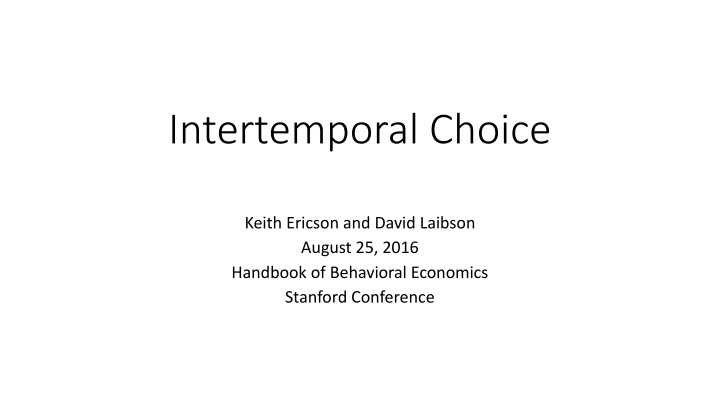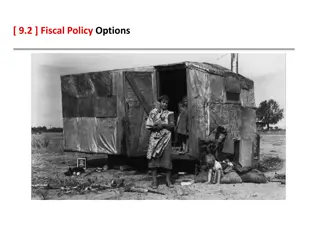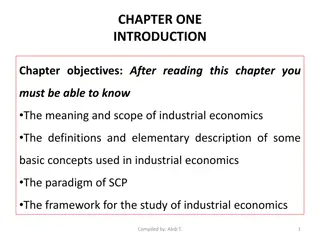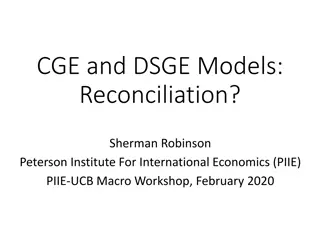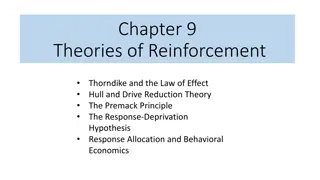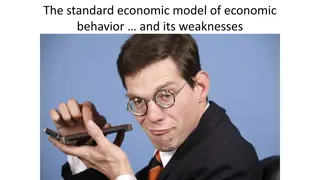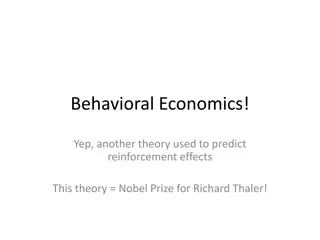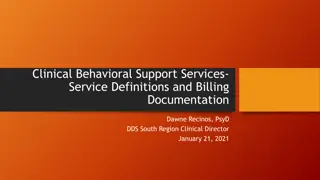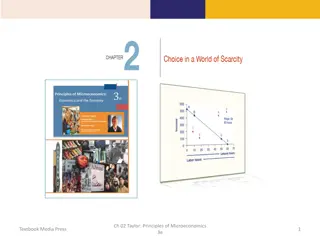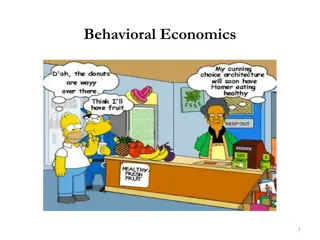Intertemporal Choice and Behavioral Economics Overview
Explore present-focused models, empirical regularities, and open questions related to intertemporal choice in behavioral economics. Concepts like hyperbolic discounting, dual-self models, psychometric distortions, and myopia are discussed using insights from prominent figures like David Hume, Plato, and Adam Smith.
Uploaded on Sep 15, 2024 | 0 Views
Download Presentation

Please find below an Image/Link to download the presentation.
The content on the website is provided AS IS for your information and personal use only. It may not be sold, licensed, or shared on other websites without obtaining consent from the author.If you encounter any issues during the download, it is possible that the publisher has removed the file from their server.
You are allowed to download the files provided on this website for personal or commercial use, subject to the condition that they are used lawfully. All files are the property of their respective owners.
The content on the website is provided AS IS for your information and personal use only. It may not be sold, licensed, or shared on other websites without obtaining consent from the author.
E N D
Presentation Transcript
Intertemporal Choice Keith Ericson and David Laibson August 25, 2016 Handbook of Behavioral Economics Stanford Conference
Outline I. II. Empirical Regularities III. Open Questions and Puzzles Present-focused models: theoretical commonalities
I. Present Focused Models 1. Hyperbolic discounting and present bias Strotz (1955), Herrnstein (1961), Phelps and Pollak (1967), Ainslie (1974), Akerlof (1991), Loewenstein and Prelec (1992), Laibson (1997), O Donoghue and Rabin (1999), Harris and Laibson (2001, 2013), Benhabib, Bisin and Schotter (2010) 2. One self temptation models Baumeister et al (1998), Muraven and Baumeister (2001), Gul and Pesendorfer (2001), Laibson (2001), Bernheim and Rangel (2004), Dekel, Lipman and Rustichini (2009) 3. Dual-self models Smith (1775), Thaler and Shefrin (1981), Shefrin and Thaler (1988), Loewenstein (1996), Loewenstein and O Donoghue (2004), Fudenberg and Levine (2006, 2011), Brocas and Carrillo (2008a, 2008b, 2012), Jackson and Yariv (2014, 2015). 4. Psychometric distortions (e.g., log time perceptions) and heuristics Read (2001), Zauberman et al (2009), Read et al (2011, 2013), Ericson et al (2015) 5. Myopia Gabaix and Laibson (2016)
David Hume (1738 A Treatise of Human Nature) In reflecting on any action, which I am to perform a twelve-month hence, I always resolve to prefer the greater good, whether at that time it will be more contiguous or remote; nor does any difference in that particular make a difference in my present intentions and resolutions. My distance from the final determination makes all those minute differences vanish, nor am I affected by any thing, but the general and more discernible qualities of good and evil. But on my nearer approach, those circumstances, which I at first over-looked, begin to appear, and have an influence on my conduct and affections. A new inclination to the present good springs up, and makes it difficult for me to adhere inflexibly to my first purpose and resolution. This natural infirmity I may very much regret, and I may endeavour, by all possible means, to free my self from it. I may have recourse to study and reflection within myself; to the advice of friends; to frequent meditation, and repeated resolution: And having experienced how ineffectual all these are, I may embrace with pleasure any other expedient, by which I may impose a restraint upon myself, and guard against this weakness."
Plato ( Socrates Phaedrus sections 246a 254e) A person is a charioteer pulled by two horses with different personalities: one of the horses is noble and of noble breed, but the other quite the opposite in breed and character. Therefore in our case the driving is necessarily difficult and troublesome.
Adam Smith (1759 The Theory of Moral Sentiments) Conflicting motivational systems: impartial spectator and the passions See Ashraf et al (2005), who call Smith the first behavioral economist
I. Present Focused Models 1. 2. 3. 4. 5. Hyperbolic discounting and present bias Temptation models Dual-self models Psychometric distortions Myopia Models are hard to pull apart empirically (e.g., Krusell et al. 2010; Gabaix and Laibson 2016) They share the unifying feature of giving priority to the present. 1. High short-run discount rates. 2. Temptation effects that arise when choosing among current feasible rewards, but not to the selection of choice sets that will determine the feasibility of future rewards. 3. A relatively myopic self/system that influences choices that determine immediate rewards, but does not influence choices for the future. 4. Present time steps are bigger than future time-steps 5. The present is easier to forecast than the future
One source of differentiation: naivite Naivite (or partial naivite) can be applied to these models. Sometimes makes no difference (ln utility eat-the-pie problem) Sometimes makes an enormous difference (O Donoghue and Rabin 1999).
Models without present focus Habit formation models (motive to tilt consumption paths upwards): e.g., Ryder and Heal (1973), Abel (1990) Anticipation models: e.g., Loewenstein (1987), Caplin and Leahy (2001) Fixed cost of delay models: Kable and Glimcher (2010) Focusing effects: Koszegi and Szeidel (2013)
II. Empirical regularities 1. High required rate of return (RRR) for money 2. High(er) RRR for consumption 3. Lack of liquidity on household balance sheets 4. Preference reversals 5. Procrastination 6. Naivite 7. Small changes in transactions costs have large consequences 8. Commitment 9. Paternalistic policies
1. High required rate of return (RRR) for money Experimental literature I: Maital and Maital (1977); Thaler (1981); Loewenstein & Thaler (1989); Prelec & Loewenstein (1991); Kirby (1997); Kirby and Herrnstein (1995); Read and Roelofsma (2003); Benhabib, Bisin, and Schotter (2010); Hardisty et al. (2011); Manzini, Mariotti, and Mittone (2014); Harrison, Lau, and Williams (2002). Experimental literature II: adjustments for curvature substantially lower the estimated discount rate: e.g., Andreoni and Sprenger (2012a, 2012b); Andersen, Harrison, Lau, and Rutstr m, (2008), Halevy (2014, 2015); Andreoni, Kuhn, and Sprenger (2015); Field data: Hausman (1979) but do they understand the tradeoff? Warner and Pleeter (2001) but confounded by service requirement Coile et al. (2002) Social Security claiming (again knowledge confound) Unstable findings (e.g., fuel efficiency): Dreyfus and Viscusi (1995) and Allcott and Wozny (2012) vs. Busse, Knittel, and Zettelmeyer (2013).
1. High required rate of return (RRR) for money High RRR Overall, relatively little present bias (when use FED methodology) Adjusting for curvature in the utility function reduces RRR But the money-earlier-or-later (MEL) literature raises fundamental methodological questions (see Chabris et al 2008). In theory, we aren t supposed to be able to infer time preferences from RRR on money flows because money flows aren t incremental utility flows People don t instantly consume everything they receive on the day of receipt as non-durables (e.g., estimate a daily MPC of less than 5%). We ll come back to this in the open questions section
2. High(er) RRR for real rewards Read rewards (time-yoked) yield high RRR, and when structurally analyzed, high discount rates and robust present bias. Many papers compare implied RRR for real rewards with money rewards and find that the RRR for real rewards are higher. Mischel et al (1970, 1989), Angeletos et al (2001), Read and van Leeuwen (1998), Read, Loewenstein, and Kalyanaraman (1999), McClure et al. (2007), Reuben, Sapienza, and Zingales (2010) , Augenblick, Niederle, and Sprenger(2015), Laibson, Maxted, Repetto, and Tobacman(2016), Bisin and Hyndman (2014), Odum, Baumann, and Rimington (2006), Odum and Rainaud (2003), Estle et al. (2007), Tsukayama and Duckworth (2010), Ubfal (2013), Lawyer et al. (2010), Shapiro (2005), Mastroubuoni and Weinberg (2009), Viscusi and Moore (1989), Della Vigna and Paserman (2005), Ben Halima and Ben Halima (2009), Paserman (2008)
3. Lack of liquidity on household balance sheets and implications thereof Low liquidity and high debt: Angeletos et al (2001); Laibson, Maxted, Repetto, and Tobacman (2016); Skiba and Tobacman (2014); however see Kaplan and Violante (2014) for an alternative perspective. High marginal propensity to consume (MPC): Stephens (2003), Mastrobuoni and Weinberg (2009), Shapiro and Slemrod (2003), Parker et al. (2013), Broda and Parker (2014), Shapiro (2005), Mastrobuoni and Weinberg (2009), Ganong and Noel (2016), Gross, Notowidigdo, Wang (2016) But see Aguiar and Hurst (2004) for a countervailing view; though they have recently been critiqued by Stephens and Toohey (2016)
4. Preference reversals Read and Van Leeuwen (1998) Read, Loewenstein and Kalyanaraman (1999) Augenblick, Niederle, and Sprenger (2015) Milkman, Rogers, and Bazerman (2009) Dellavigna and Malmendier (2004, 2006) Kuchler (2016) Fedyk (2016)
5. Procrastination Ariely and Wertenbroch (2002) Choi, Laibson, Madrian, and Metrick (2002) Dellavigna and Malmendier (2004, 2006) Bisin and Hyndman (2014) Reuben, Sapienza, and Zingales (2015)
6. (Partial) Naivite Dellavigna and Malmendier (2004, 2006) Kuchler (2016) Augenblick and Rabin (2016) Fedyk (2016)
7. Small changes in transactions costs have large consequences Choice architecture literature (e.g., Madrian and Shea 2002). Bettinger, Long, Orepoulos, Sanbonmatsu (2012) on FAFSA simplification, Pallais (2015) on $6 reduction in sending test score Take up of social benefits: Currie (2006), Aizer (2007) in Medicaid, Bahargava and Manoli (2015) Planning prompts (Milkman et al. 2013) Pick up of HIV tests (Thornton 2008)
8. Commitment Commitment: choice set reduction that has no external strategic benefit. In the laboratory, commitment can be induced: Wertenbroch (1998); Ariely and Wertenbroch (2002); Bisin and Hyndman (2014); Karlan, Gine and Zinman (2010); Ashraf et al (2006) and Kaur, Kremer, and Mullainathan (2010); Houser, Schunk, Winter, and Xiao (2010); Royer, Stehr, and Sydnor (2012); Beshears et al (2014); Augenblick, Niederle, and Sprenger (2015); Schilbach (2015); for a review see Bryan, Karlan and Nelson (2010). However, the willingness to pay for commitment is quite low. And the fraction committing is sometimes quite low. Ariely and Wertenbroch (2002); Augenblick, Niederle, and Sprenger (2015); and Beshears et al (2014) are exceptions.
9. Paternalistic policies Social Security (Feldstein 1985, Beshears et al 2016) EITC (Lockwood, 2016) Defined contribution savings plans (Laibson et al 1997) Compulsory education Usury laws Most of these laws could be interpreted as paternalistic control of others, rather than a preference for commitment: Fedyk (2016).
III. Puzzles and Open Questions 1. Impatience over monetary flows instead of consumption 2. Multiple mechanisms, including probability weighting 3. Negative discounting 4. Heterogeneity and domain generality 5. Duration of the present 6. What is tempting 7. Missing commitment 8. Retirement saving adequacy 9. Measuring temptation 10. Malleability and self-management 11. Welfare and policy 12. Alternative psychological conceptions
1. Impatience over monetary flows instead of consumption Critical of money-earlier vs. later (MEL) Coller and Williams (1999), Cubitt and Read (2007), Chabris et al (2008), Epper, Fehr-Duda, and Bruhin (2011), Augenblick, Niederle, and Sprenger (2015), Ericson et. al (2015), Cohen et al (2016), Reuben, Sapienza, and Zingales (2015) Assume that choices in MEL experiments are equivalent to choices over time-dated utility flows Thaler (1981); Kirby and Herrnstein (1995); Loewenstein and Prelec (1999); Andersen et al 2008, Benhabib et al. 2010, Halevy 2014, 2015). Other mechanisms at play in the MEL literature: trust, risk, probability weighting, or heuristics (see next slide).
2. Multiple mechanisms, including probability weighting Risk and probability weighting: Souzou (1998), Dasgupta and Maskin (2005), Halevy (2008), Epper, Fehr-Duda, and Bruhin (2011), Saito (2011), and Andreoni and Sprenger (2012b); Anderson and Stafford (2009) Trust and Forecasting Beliefs: Alternative interpretations of the marshmallow task (see McGuire and Kable 2013). Heuristics: Read et al (2012, 2013); Ericson et al (2015)
3. Negative discounting (wrt long-run sequences) Barsky et al, (1997): subjects prefer a flat or rising slope of the real consumption path when the real interest rate is zero. For a review see Loewenstein and Prelec (1993). See also Loewenstein and Sicherman (1991) and Bhatia et al (2016). Mechanisms: Habits: Ryder and Heal (1973), Abel (1990) Reference points: Anticipation: Loewenstein (1987); Caplin and Leahy (2001)
4. Heterogeneity and domain generality Mischel et al (1970, 1989): marshmallow test is correlated (0.16) with personality scales that are designed to measure self-regulatory capacity Reuben, Sapienza, and Zingales (2010) (R2=0.12); Harrison, Lau and Rustr m (2010); Benjamin et al (2016); Meier and Sprenger (2013) ; Tanaka et al (2010); Cadena and Keys (2011); Bettinger and Slonim (2007); Sutter et al. (2013); Castillo et al. (2011); Golsteyn, Gronqvist and Lindahl (2013) ; Daly, Delaney, and Harmon (2009); Becker et al. (2012); Wolbert and Riedl (2013); Dohmen et al. (2010); Benjamin, Brown and Shapiro (2013); Burks et al. (2009); Chabris et al (2008); Falk et al. (2015); Chapman (1996) Kirby (2009) and Meier and Sprenger (2010) test re-test reliability of 0.4 to 0.8 Variation with SES: Lawrance (1991); Viscusi and Moore (1989); Meier and Sprenger (2010); Laibson, Repetto, and Tobacman (2001) Age-based effects in theory: Robson and Samuelson (2009)
5. Duration of the present McClure et al (2007): 10 minute delay (of juice) not now , McClure et al (2004): money today (but more than 1 hour delayed) is now .
7. Missing commitment Is it missing? Mortgage? 401(k)? Social Security? (crowd out?) Exceptions? Internet blocking software (that few people use); personal trainers (that few people can afford or use). Why is there not a successful market selling commitment for commitment s sake? Laibson (2015): cost, naivite, option value jointly kill commitment?
8. Retirement saving adequacy Scholz , Seshadri , Khitatrakun (2006) Munnell et al (2012, 2013, 2015) Aguiar and Hurst (2004) vs. Stephens and Toohey (2016) Skinner (2006) Laibson and Yadlon (2016)
9. Measuring temptation Toussaert (2016) Sadoff, Samek, Sprenger (2016)
10. Malleability and self-management Growth mindset (Dweck et al) Grit (Duckworth et al) Pre-school interventions (Heckman)
11. Welfare and policy Normative discount functions both intra- and inter-generational: Sen (1957), Schelling (1995), Gollier (2012) Climate change: Stern (2007) and Goulder and Williams (2012) Welfare criteria vis- -vis intertemporal choice? Laibson et al (1997); Beshears et al (2008); Bernheim and Rangel (2008)
12. Alternative and/or complementary psychological conceptions Grit Construal Theory and Query Theory Conscientiousness and other personality constructs Ego depletion Multiple systems Psychologists take discounting for granted and have turned their attention to inter-personal and situational sources of variation; especially interventions that (persistently) improve self-regulation
Outline I. II. Empirical Regularities III. Open Questions and Puzzles Present-focused models: theoretical commonalities
I. Present Focused Models 1. Hyperbolic discounting and present bias 2. 3. 4. 5. Temptation models Dual-self models Psychometric distortions (e.g., log time perceptions) Myopia
II. Empirical regularities 1. High RRR for money 2. Lack of liquidity on household balance sheets 3. High RRR for consumption 4. Preference reversals 5. Procrastination 6. Naivite 7. Small changes in transactions costs have large consequences 8. Commitment 9. Paternalistic policies
III. Puzzles and Open Questions 1. Impatience over monetary flows instead of consumption 2. Multiple mechanisms, (e.g., probability weighting) 3. Negative discounting 4. Heterogeneity and Domain generality 5. Duration of the present 6. What is tempting 7. Missing commitment 8. Retirement saving adequacy 9. Measuring temptation 10. Malleability and self-management 11. Welfare and policy 12. Alternative psychological conceptions
